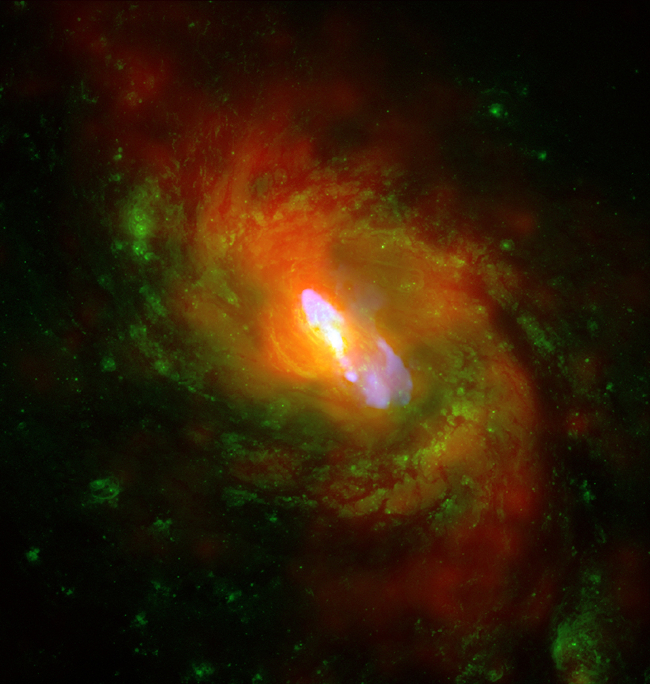
 Credit: X-ray (NASA/CXC/MIT/C.Canizares, D.Evans et al), Optical (NASA/STScI), Radio (NSF/NRAO/VLA)
Credit: X-ray (NASA/CXC/MIT/C.Canizares, D.Evans et al), Optical (NASA/STScI), Radio (NSF/NRAO/VLA)
Blowback
Black holes are sloppy eaters. They can swallow enormous quantities of cosmic material (gas, dust, stars, planets) but sometimes their appetite gets the better of them. When this happens, the enormous energy generated by the black hole can drive excess matter out into space. If the black hole happens to be of the supermassive type, eating hungrily at the center of its host galaxy, the amount of energy generated by the black hole can be enormous. An outstanding question is what influence this outpouring of matter has on the galactic environment. New X-ray observations with the Chandra X-ray Observatory of the active galaxy NGC 1068 have helped answer this question. The image above shows a color composite image of the galaxy in X-rays (in red), along with optical data from the Hubble Space Telescope in green and radio data from the Very Large Array in blue. The Chandra images and X-ray spectra show that the black hole at the center of NGC 1068 produces a strong outflowing wind of material traveling at about a million miles per hour. Astronomers believe that wind is generated as infalling material is accelerated and heated as it swirls toward the black hole. Temperatures in the infalling material are so large that it glows brightly in X-rays, and the radiation produced is strong enough to blow away some of this infalling material. This wild wind has a big impact on the center of the host galaxy, heating the galaxy and perhaps suppressing star formation out to a distance of 3,000 light years from the black hole.
Published: March 8, 2010
<
HEA Dictionary ● Archive
● Search HEAPOW
● Other Languages
● HEAPOW on Facebook
● Download all Images
● Education ● HEAD
>

Each week the HEASARC
brings you new, exciting and beautiful images from X-ray and Gamma ray
astronomy. Check back each week and be sure to check out the HEAPOW archive!
Page Author: Dr. Michael F. Corcoran
Last modified Monday, 26-Feb-2024 17:10:58 EST


